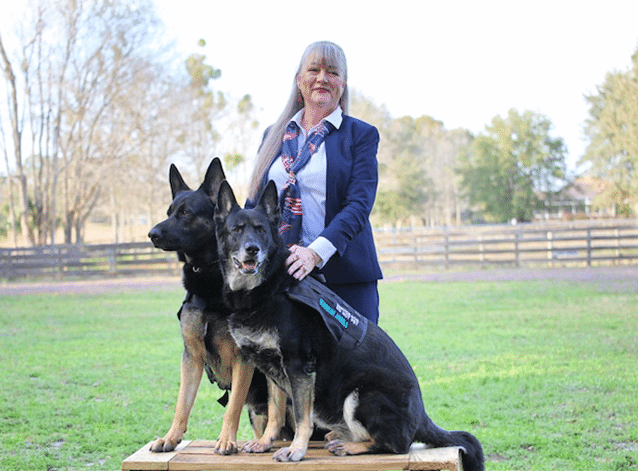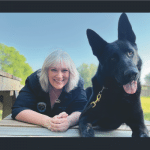As summer draws to an end, the fun at Guardian Angels Medical Service Dogs is just beginning! The Community Mutt Strut, a free virtual and in-person event, is coming to Pittsburgh in person on September 10th and will also be held virtually from September 7th-10th. (more…)
At Guardian Angels, we teach the dog to walk nicely on the leash by first teaching them to be attentive to us. There is no collar or leash involved in the beginning. We use a yummy soft treat to reward them for their good behavior. It’s important to avoid crunchy treats because they take too long for the dog to chew, and by the time they finish them, they’ve forgotten what they were being rewarded for. (more…)
At Guardian Angels Medical Service Dogs, we rescue, raise, train, donate and pair service dogs for individuals who have permanent disabilities. A disability is defined by law as a physical or mental impairment that substantially limits one or more major life activity.
Service dogs can be trained to alert to seizures, manage the symptoms of PTSD, assist with mobility, diabetic alerts, seizures, and so much more. With their obedient and intelligent natures, dogs can assist their recipient with a wide range of tasks tailored to the needs of their recipient through our extensive training.
What Do Service Dogs Do?
All of our service dogs are custom trained to meet the needs of their recipient. They can assist with a large range of tasks, including but not limited to:
- Retrieving dropped items, assisting with balance, opening/closing doors or drawers, turning on/off lights, hitting door or elevator buttons, etc.
- Redirecting and calming the recipient during anxiety/panic attacks, night terrors or flashbacks.
- Alerting in advance to seizures
- Alerting to diabetic changes
- And more
Each recipient is evaluated by our team, and the service dog receives special training specifically tailored to mitigate the challenges of the recipient’s disability.
How Do You Qualify for a Service Dog Through Guardian Angels?
First, you must be cognitively, physically, and financially capable of going through our 10-day pairing process and be solely responsible for the care and handling of your service dog for the future of your relationship. Our dogs require certain communication, exercise, and care, which are all important elements of a successful relationship between the service dog and the recipient. The recipient is expected to be 50% of the team’s success.
If someone is not cognitively capable of going through our training or does not have the physical capabilities to provide the dog with all his/her care, handling and playtime, a service dog may not be the right answer. This does not necessarily exclude people with brain injuries or those who use a wheelchair from getting a service dog. We review each case individually and determine their level of ability to care for and work with their service dog.
Secondly, we have expectations of the individual to provide the service dog with the premium diet and medical care we require. We also expect them to be able to provide their service dog with toys and anything else he/she would require. The recipient must have the expendable income to care for their service dog.
Once we get beyond these variables and the individual has qualified on these points, we will evaluate them to make sure they are in a stable living environment. Our recipients cannot, for example, be homeless. They must have a stable housing situation that is conducive to them providing the proper environment for their service dog. Additionally, recipients must be free of addiction issues.
If the recipient is a single individual, they cannot have other dogs in the home. However, if the recipient is in a family situation, we may make allowances for other dogs in the home. This is because the recipient’s sole responsibility should be to care for their service dog while the family cares for the other pets in the home.
The Process of Pairing the Dog with the Individual
At Guardian Angels Medical Service Dogs, we know our dogs very well after training them for 1 1/2 to 2 years. We understand their level of drive, whether they would cohabitate well with other dogs or cats, whether they are more laid back or high energy, etc. We consider these factors about each service dog while we get to know our potential recipients. We learn about the recipient’s job, family situation, activity level, hobbies, and more to help ensure that we pair them with a service dog that best matches their lifestyle and needs. These factors all play a role in which service dog we choose to mitigate the issues for that individual. We go through a variety of variables to figure out what dog will be most suitable for the recipient before we do the final training.
Want to Learn More About Applying for A Service Dog? Contact us Today!
If you have any questions about qualifying for a service, please contact our team today or visit our website, go to the Applications tab and then go to Service Dog Application for more information.
Service dogs, medical service dogs, and assistance dogs are all names for the same thing. They are the only type of dog that is protected by federal law under the Americans with Disabilities Act (ADA).
This protection means that service dogs are permitted in any place that the public is permitted, such as grocery stores, malls, movie theaters, hotels, etc. They are protected by federal law because they are much like a piece of medical equipment with a heartbeat.
They do not fall under any pet regulations, such as a pet fee for a hotel room, since they are in no way considered a pet.
What are Service Dogs Trained to Do?
Service dogs are trained to perform a wide array of tasks that are then used to help mitigate the challenges that are presented by a disability to an individual.
Many individuals that we work with at Guardian Angels have been self-isolated at home or have caregivers, so they are unable to independently enjoy major life functions.
Service dogs can be trained for:
Diabetic Alert Dog
The dog is trained to alert the recipient if their sugar levels are too high (hyperglycemia) or too low (hypoglycemia). When the service dog alerts the recipient, the recipient knows to test their blood and take their medication accordingly to adjust their blood sugar levels. The dog can also be trained to alert other people in the home or set off an alarm in the event that the recipient needs medical attention.
Mobility Assistance Dog
Service dogs can be trained to help people with disabilities perform daily tasks such as picking up dropped items, opening/closing doors, turning on/off lights, pressing automatic door or elevator buttons and performing an array of other activities. A mobility assistance dog is commonly paired with a recipient who has a condition such as, but not limited to, a spinal cord injury, brain injury, arthritis, cerebral palsy, or muscular dystrophy. They can be trained to brace their recipients who have balance issues, and some specialize in assisting people in wheelchairs.
Seizure Alert Dog
Service dogs can be trained to assist recipients before, during, and after a seizure. They are trained to alert the recipient before they have a seizure and can help the recipient during the seizure by protecting their head from injury, and they help after a seizure by helping the individual to reacclimate and feel secure.
PTSD Service Dog
Service dogs can be trained to alert their recipient in advance if they are going to have a nightmare, a flashback, a panic attack, etc. They are specifically scent trained to help individuals who have conditions such as post-traumatic stress (PTSD), anxiety, depression, etc. These service dogs help their recipient go out in public again while serving as a physical barrier between their recipient and strangers entering their personal space. Additionally, PTSD service dogs are not only trained in shielding, but also to redirect and ground their recipient from anxiety/panic attacks, flashbacks, and waking them from impending nightmares.
Service dogs have a highly sophisticated sense of smell that allows them to alert in advance helping their recipients function in a safer, more normal manner. Depending on the situation, they can also be trained to go find a family member in the household or push a monitored help button if necessary.
The medical service dogs we train here at Guardian Angels go through no less than 1,500 hours of service dog training over the course of a year and a half to two years. Our extensive training includes, but is not limited to desensitization, basic and advanced commands, public access training, and socialization.
Want to Learn More About Service Dogs? We’re Here to Help!
At Guardian Angels Medical Service Dogs, we are happy to answer any questions you may have about service dogs and how they are trained. Feel free to contact us today to learn more!





